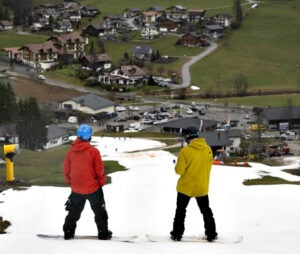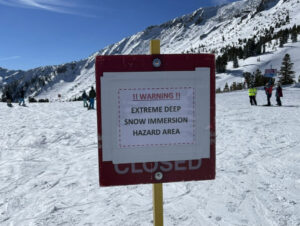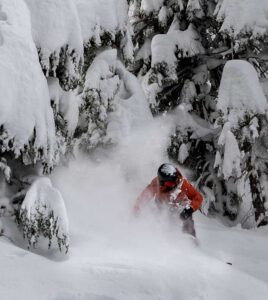A ski season without snow? That’s been the dilemma this year at many European ski resorts.

While Tahoe ski resorts are universally blessed with an abundance of snow in the 2022-23 season, overseas many ski resorts are already closed for perhaps the season.
For many people across North America and Europe, this has been the winter of ski vacations sans skiing. And the idea of a ski trip without skiing is a non-starter for the masses.
Half of the 7,500 ski slopes in France were closed the first week of January because of the rise in temperatures, though many resorts got snow later in the month.
Several small Switzerland ski areas have been forced to close in the middle of the Swiss school holidays, which is disastrous for some smaller ski areas, especially because of a slow start to the season in Europe. While the eastern part of the European Alps has experienced decent snowfall this season, the western region in Switzerland and France has been having one of their worst seasons ever.
“I have never seen a worse winter, and I have been working with the ski lifts here for 20 years,” said Martin Weilenmann, CEO of the Tschiertschen ski lifts in the Swiss canton of Graubünden.
It’s no secret what is happening – climate change.
“Climate change is impacting where, when and how much snow falls, if at all,” said Elizabeth Burakowski, a professor at the University of New Hampshire who studies how landscapes interact with surface climate. “Winter temperatures are warming unequivocally in regions with seasonal snow cover, where most ski resorts are located.”
Dealing with warm temperatures and a lack of snow has been a constant this season across the Alps for the International Ski and Snowboard Federation (FIS), with Mother Nature and global warming having just as much say about when and where to hold races as the sport’s governing body.

Warm weather and a lack of snow wiped out nearly a month of racing at the start of this season. Also, preseason training on melting European glaciers is heading toward extinction and the impact of climate change on the schedule is being seen even in January.
“There’s a very real threat to what we know and love from winter,” American skiing standout Mikaela Shiffrin said. “We get really caught up in our world and the medals and wins and victories and records and everything. But what we hope is to be able to enjoy skiing and winter sports and winter recreation for many, many years to come. And that’s under threat right now.”
2023 CALIFORNIA, UTAH SNOW TOTALS: Many ski resorts throughout California and Utah have already exceeded their season totals for last season. Outside of those two states, the majority of U.S. ski resorts have experienced a subpar season for snow totals.
Located on California’s Eastern Sierra range, approximately 100 miles south of the Nevada state line and 50 minutes from the eastern gate of Yosemite, Mammoth Mountain had received the most snow in North America this season (as of Feb. 21) with a whopping 538 inches at its summit.
Alta ski resort in Utah was second with 502 inches, followed by three other Utah resorts with between 431 to 498 inches. Alyeska in Alaska has 425 inches, followed by four California resorts – Dodge Ridge (411), Kirkwood (405), Sierra-at-Tahoe (402), and Palisades Tahoe (395).
2022 TAHOE SNOW TOTALS: The Tahoe region has experienced its down seasons in the past decade or more, including last year when many Tahoe ski resort failed to reach 300 inches in season snow totals.

Palisades Tahoe was an exception, getting 394 inches, the most among Tahoe ski resorts. Palisades Tahoe received 58 inches in mid-April, more than it received during the first three months of 2022. Thanks to the late snowfall, Palisades Tahoe stayed open until May 30.
A year ago, the Sierra snowpack measured a disappointing 38% of average on April 1. Tahoe ski resorts reported snow totals between 65% and 91% of their season averages, according to OpenSnow.com.
WEATHER FORECAST: There was a dusting of snow Tuesday (Feb. 21) that left a few inches at Tahoe ski resorts by Wednesday morning.
Snow showers returned Wednesday afternoon in Tahoe and are expected to continue into Saturday, dropping perhaps as much as 20 inches. A break in the weather arrives Saturday afternoon and last into Sunday morning.
The extended forecast calls for a weak system arriving Sunday afternoon into Monday morning. A stronger storm will likely move in Monday afternoon and could last for two days. The cold and active pattern could remain into the second week of March.